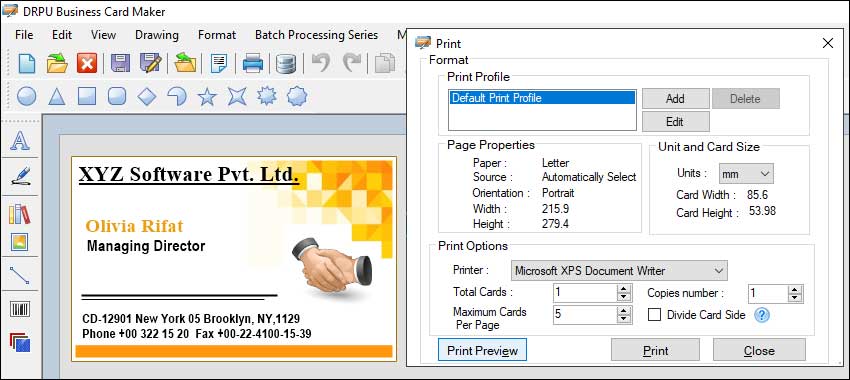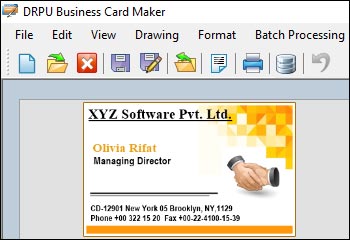Ensure the Business Card Design is Readable and Legible to all Audiences
When designing a business card, it is important to ensure that the design is readable and legible to all audiences, including those with visual impairments. Here are some tips to ensure that your business card is accessible to everyone:
-
Choose the Right Font:
When selecting a font for your business card, choose a font that is easy to read and legible, even at small sizes. Sans-serif fonts such as Arial or Helvetica are generally easier to read than serif fonts like Times New Roman or Garamond. It's also important to choose a font that is not too thin or condensed, as this can make it difficult to read.
-
Provide Enough Contrast:
The contrast between the text and the background is important for legibility. Use a high-contrast color scheme, such as black text on a white background or white text on a dark background. Avoid using low-contrast color schemes, such as light gray text on a white background, as this can be difficult to read.
-
Use a Large Enough Font Size:
The font size on your business card should be large enough to be easily readable. A font size of at least 12 points is recommended. If your business card includes a lot of information, consider increasing the font size to make it easier to read.
-
Provide Alternative Formats:
Consider providing alternative formats for your business card, such as a Braille version or an audio description. This can make your business card accessible to people with visual impairments.
-
Use Simple and Clear Design Elements:
Keep your business card design simple and clean. Avoid using too many design elements or too much text, as this can make the card cluttered and difficult to read. Use simple shapes and lines, and make sure that any images or graphics are clear and easy to interpret.
-
Test Your Design:
Once you have designed your business card, test it to ensure that it is readable and legible. Ask people with visual impairments to review your card and provide feedback on its accessibility. This can help you make any necessary changes to improve the card's accessibility.
Conclusion: Designing a business card that is readable and legible to all audiences, including those with visual impairments, requires careful consideration of font choice, font size, color contrast, design elements, and alternative formats. By following these tips and testing your design, you can ensure that your business card is accessible to everyone.
Different Printing Options for Business Cards and their Pros and Cons
-
Digital Printing:
Digital printing is a popular choice for printing business cards, especially for small print runs. This printing method uses a digital printer to transfer the design directly onto the paper or cardstock.
Advantages of digital printing include:⬗ Lower setup costs: Digital printing doesn't require plates or screens, so setup costs are lower than other printing methods.
⬗ Fast turnaround times: Digital printing is ideal for short print runs, as the setup time is minimal and the printing process is quick.
⬗ Customization: Digital printing allows for customization of each card, such as adding individual names or contact number.
Disadvantages of digital printing include:⬗ Limited color range: Digital printing uses a four-color process, which can result in limited color accuracy and range.
⬗ Lower quality: Digital printing may produce lower quality prints compared to other printing methods, especially when printing images or graphics.
⬗ Cost per unit: Digital printing can be more expensive per unit compared to other printing methods for larger print runs.
-
Foil Stamping:
Foil stamping is a printing method that uses a press to apply a metallic or colored foil onto the paper or cardstock. This method produces prints with a metallic or glossy finish, making it ideal for high-end or luxury business cards.
Advantages of foil stamping include:⬘ High-end finish: Foil stamping produces prints with a metallic or glossy finish, giving the card a high-end and luxurious look.
⬘ Customizable: Foil stamping allows for customization of each card, such as adding individual names or contact information.
⬘ Versatility: Foil stamping can be used on a wide range of paper and cardstock options, making it a versatile printing method.
Disadvantages of foil stamping include:⬘ Higher cost: Foil stamping is a more expensive printing method compared to other options.
⬘ Limited color range: Foil stamping is limited to a single color or a limited range of colors.
⬘ Limited detail: Foil stamping can only produce simple designs or text, as intricate details may not be possible to achieve.
-
Offset Printing:
Offset printing is a traditional printing method that uses plates to transfer ink onto the paper or cardstock. This method is ideal for large print runs and produces high-quality prints with vibrant colors.
Advantages of offset printing include:⬢ High-quality prints: Offset printing produces high-quality prints with accurate colors and sharp details, making it ideal for printing images or graphics.
⬢ Cost-effective for larger print runs: Offset printing becomes more cost-effective for larger print runs, as the setup costs are amortized over a larger number of prints.
⬢ Wide range of paper and cardstock options: Offset printing can accommodate a wide range of paper and cardstock options, including thicker stocks and specialty finishes.
Disadvantages of offset printing include:⬢ Higher setup costs: Offset printing requires the creation of plates, which can be expensive for small print runs.
⬢ Longer turnaround times: Offset printing has a longer setup time compared to digital printing, which can result in longer turnaround times.
⬢ Limited customization: Offset printing doesn't allow for customization of individual cards, such as adding individual names or contact information.
-
Letterpress Printing:
Letterpress printing is a traditional printing method that uses a press to transfer ink onto the paper or cardstock. This method produces prints with a distinct tactile feel, making it ideal for high-end or luxury business cards.
Advantages of letterpress printing include:⬡ High-end finish: Letterpress printing produces prints with a distinct tactile type of feel, giving the business card a high-end finish.
⬡ Wide range of paper and cardstock options: Letterpress printing can accommodate a wide range of paper and cardstock options, including thicker stocks and specialty finishes.
⬡ Customizable: Letterpress printing allows for customization of each card, such as adding individual names or contact information.
Disadvantages of letterpress printing include:⬡ Higher cost: Letterpress printing is a more expensive printing method compared to other options.
⬡ Limited color range: Letterpress printing is limited to a single color or a limited range of colors.
⬡ Longer turnaround times: Letterpress printing has a longer setup time compared to digital printing, which can result in longer turnaround times.

-
Embossed Printing:
Embossed printing is a printing method that uses a press to create a raised or indented design on the paper or cardstock. This method produces prints with a distinct 3D texture, making it ideal for unique and eye-catching business cards.
Advantages of embossed printing:⬥ Unique finish: Embossed printing produces prints with a distinct 3D texture, giving the card a unique and eye-catching finish that stands out from other business cards.
⬥ Versatility: Embossed printing can be used on a wide range of paper and cardstock options, making it a versatile printing method.
⬥ Durable: Embossed printing creates a lasting impression on the paper or cardstock, making it durable and resistant to wear and tear.
⬥ Customizable: Embossed printing allows for customization of each card, such as adding individual names or contact information.
Disadvantages of embossed printing include:⬥ Higher cost: Embossed printing is a more expensive printing method compared to other options.
⬥ Limited color range: Embossed printing is limited to a single color or a limited range of colors.
⬥ Limited detail: Embossed printing can only produce simple designs or text, as intricate details may not be possible to achieve.
Conclusion: Choosing the best printing method for your business cards depends on your budget, design, and desired finish. Digital printing is ideal for short print runs and customization, while offset printing is cost-effective for larger print runs and produces high-quality prints. Letterpress printing is ideal for high-end or luxury business cards, while embossed printing and foil stamping produce unique and eye-catching finishes. It's important to consider the advantages and disadvantages of each printing method and choose the one that best fits your needs.
Best Practices for Designing Business Cards for International Audiences
When designing business cards for international audiences, there are several best practices to consider to ensure that the card is effective and well-received. Here are some tips to keep in mind:
-
01 Keep it Simple:
When designing a business card for international audiences, it's important to keep the design simple and easy to understand. Avoid using overly complicated design elements or graphics that may be difficult to interpret across different cultures.
-
02 Provide Accurate Translations:
If you are including translations on your business card, make sure that they are accurate and grammatically correct. Hire a professional translator if necessary to ensure that the translations are of high quality and accurate.
-
03 Use Appropriate Colors:
Colors can have different meanings in different cultures, so it's important to choose colors that are appropriate for the audience you are targeting. For example, in Western cultures, black is often associated with sophistication and professionalism, while in some Asian cultures, it may be associated with mourning or death.
-
04 Choose Appropriate Fonts:
Fonts can also have cultural connotations, so it's important to choose fonts that are appropriate for the audience you are targeting. For example, script fonts may be appropriate for a business card targeting a female audience, but may not be as appropriate for a business card targeting a more masculine audience.
-
05 Include Cultural Elements:
If you are targeting a specific culture, consider incorporating cultural elements into your design. This can include symbols, images, or colors that are associated with the culture you are targeting. However, be sure to do your research to ensure that you are using these elements appropriately and respectfully.
-
06 Consider Local Customs:
When designing a business card for an international audience, it's important to consider local customs as well as etiquette. For example, in some cultures, it may be more appropriate to exchange business cards by using the both hands, or to include honorifics when addressing someone.
-
07 Consider Different Languages:
If you are designing a business card for an international audience, consider including multiple languages on the card. This can be done by including translations of key information such as your name, job title, and contact information. You can also consider using symbols or icons to convey information that may be difficult to translate.
Conclusion: Designing a business card for international audiences requires careful consideration of different languages, cultural preferences, and local customs. By following these best practices and doing your research, you can create a business card that is effective and well-received across different cultures.
